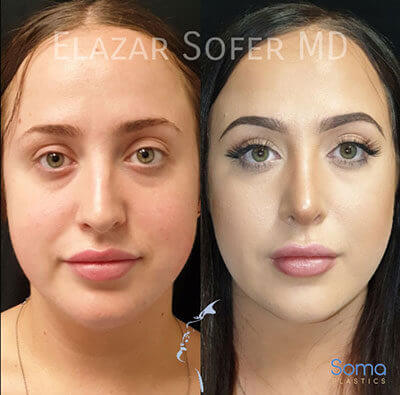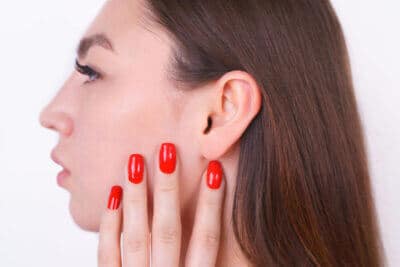Your nose is often the first feature people notice about your face. Our doctors know how changing one part of the nose can affect the way it looks or functions. That is why we make sure your nose job looks natural and functions properly.
Before and after rhinoplasty procedures, our doctors consider your skin type, face architecture, and the desired functionality of your nose, so you have a stress-free experience and fast recovery.
What to Know About Rhinoplasty Before and After
Ideally, if you are interested in an elective rhinoplasty procedure, you should be done growing. Most women typically stop growing between 15 and 16 years old. Male rhinoplasty candidates usually wait until they are 17 or 18 years old before undergoing this procedure.
No matter your sex, you should be in overall good health and avoid smoking before and after rhinoplasty procedures. Smoking limits blood flow through the body and leads to a higher risk of tissue damage.
Reasons to Get a “Nose Job”

While many people elect to have a rhinoplasty procedure for their appearance, you may want to breathe better. Often, patients who have had traumatic accidents, injuries, or illnesses need help opening their nasal passageways to improve oxygen flow. Rhinoplasty can also improve patients’ sleep and their ability to exercise.
If you want to breathe better, your rhinoplasty procedure may include removing or reshaping bumps in the bridge of your nose, the tip of your nose, your nostrils, or the overall shape and size of your nose.
Frequently, your doctor will take additional cartilage from your nasal septum to reform your nose. However, if you need to correct a previous surgery or injury, doctors may also use cartilage from an ear or rib.
This kind of procedure requires the skill of the plastic surgeons at Soma Plastics. Removing and replacing cartilage can cause scarring and is a complicated procedure to perform. Before you consider rhinoplasty, discuss your options and expectations with one of our doctors.
Prepare for Your Procedure
Use these guidelines to help you prepare for your rhinoplasty procedure:
- Do not take any form of aspirin. Aspirin causes blood to thin and can complicate the procedure.
- Begin, or continue, taking multi-vitamins to boost your immune system and promote a fast recovery.
- Fill your prescriptions before your surgery date.
- Stock your pantry with light, easy-to-eat meals like soups and crackers.
- Buy cotton swabs, hydrogen peroxide, tape, and gauze for post-surgery hygiene.
- If you experience signs of the flu, a cold, or another illness, contact your doctor to discuss your options and talk about rescheduling your procedure.
- Arrange for a driver to take you home after the procedure and perform routine tasks for the first 24 hours after surgery.
Starting at midnight the night before your surgery, you will not be allowed to eat, so you may feel hungry when you get home. Consider preparing a small meal and keeping it in the refrigerator, so you don’t have to cook while you recover.
Wear simple, comfortable clothing while you recover, like loose-fitting tee shirts and button-downs. Do not apply makeup, and don’t use any pins, hair ties, wigs, or hair accessories.
Rhinoplasty procedures generally take 1.5 to 3 hours to complete.
How Will You Feel Afterward?
While the total recovery time for a rhinoplasty procedure lasts about two weeks, the first 48 hours are the most uncomfortable. Still, with the proper medication and rest, you can easily control this discomfort.
When you are released from the hospital, you will wear a splint outside your nose. Occasionally, you may also have smaller splints inside your nose.
To prevent swelling and lessen bruising, sleep with pillows to prop up your head and ice your eyes and cheeks as often as possible for the first two days. You may feel groggy, so give yourself plenty of time to sleep while you recover.
Expect bloody discharge in the first few days after your surgery. Use Q-tips dipped in hydrogen peroxide to clean your face and replace gauze as needed. However, do not scrub, wipe, or blow your nose for 14 days to allow it time to heal.
After the first week, you can remove your splints. However, limit your physical activity for another week or two to protect your nasal bones and cartilage from accidents that may cause damage. You also cannot wear glasses for 5 to 6 weeks after your surgery.
Women are often interested in the rhinoplasty before and after due to the cosmetic appeal, while men seek out the procedure due to breathing issues at night or during workouts.
Whatever the reason for your interest, Soma Plastics has the expertise you need to accomplish this complex procedure. Call us today and ask us how we can increase your confidence and breathing capability with rhinoplasty.

